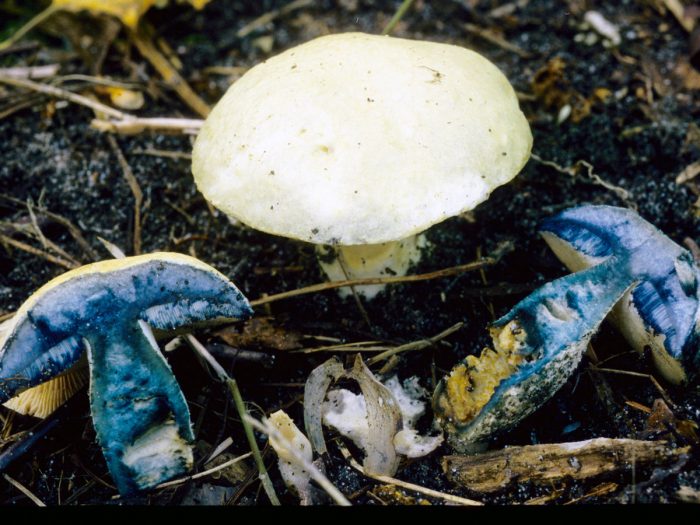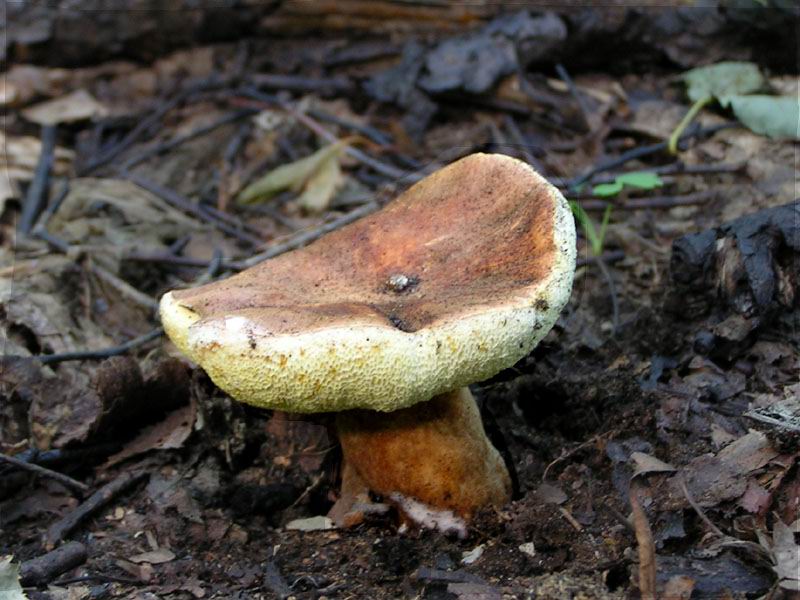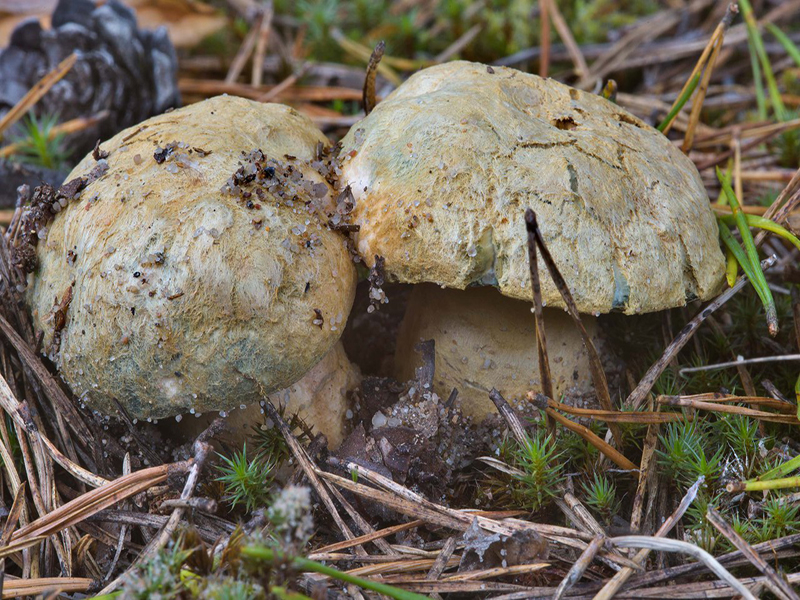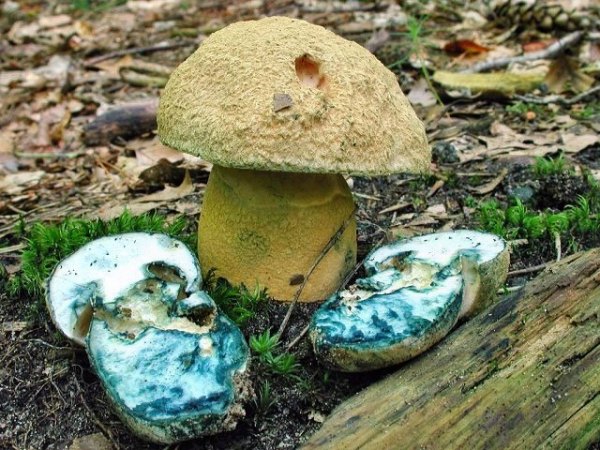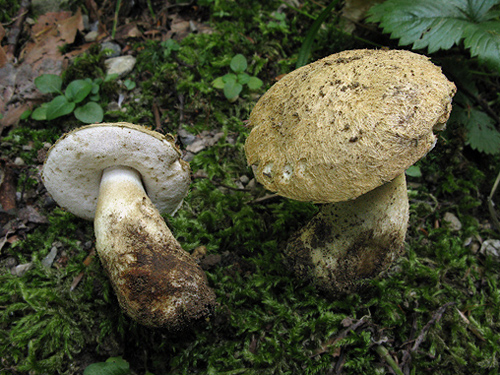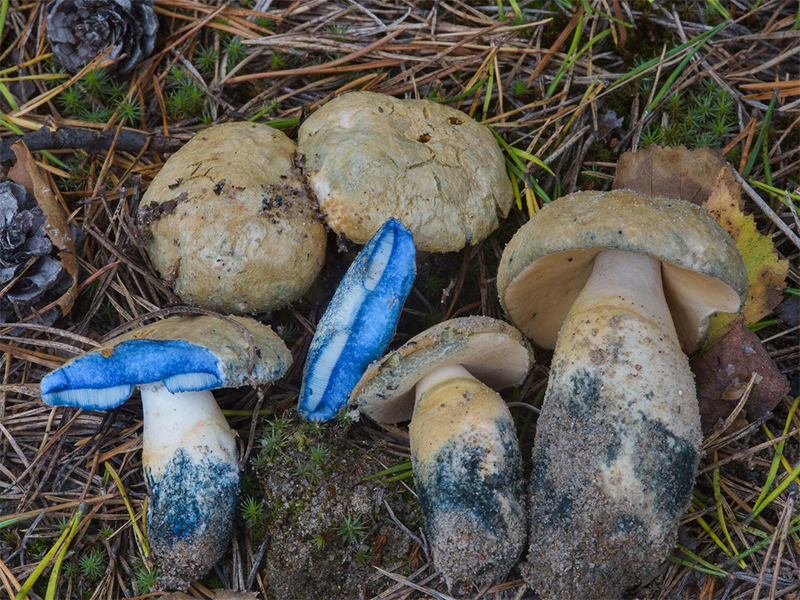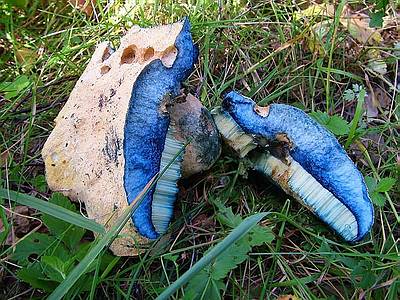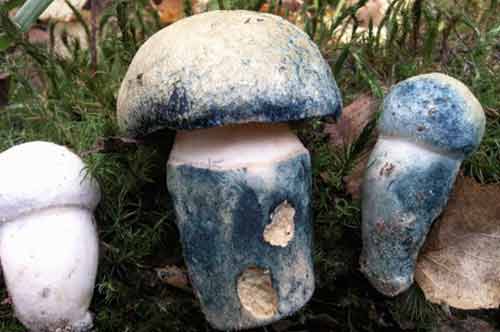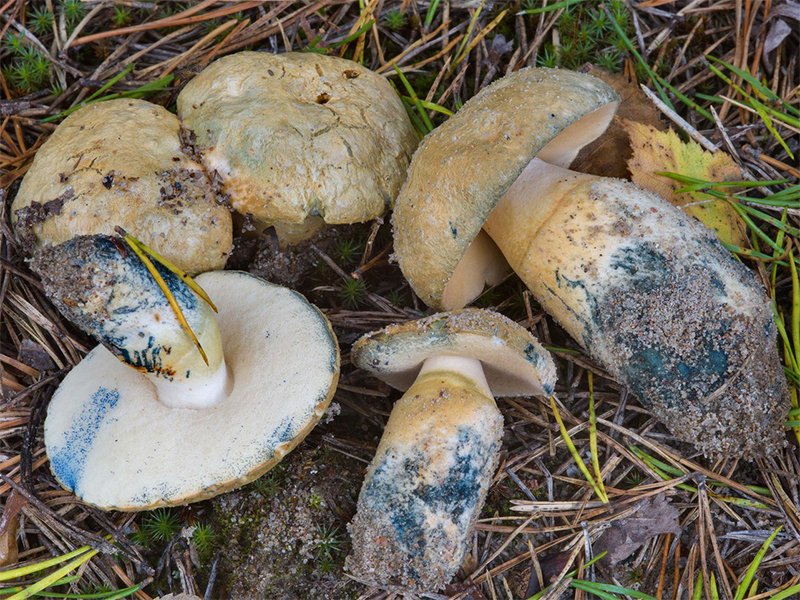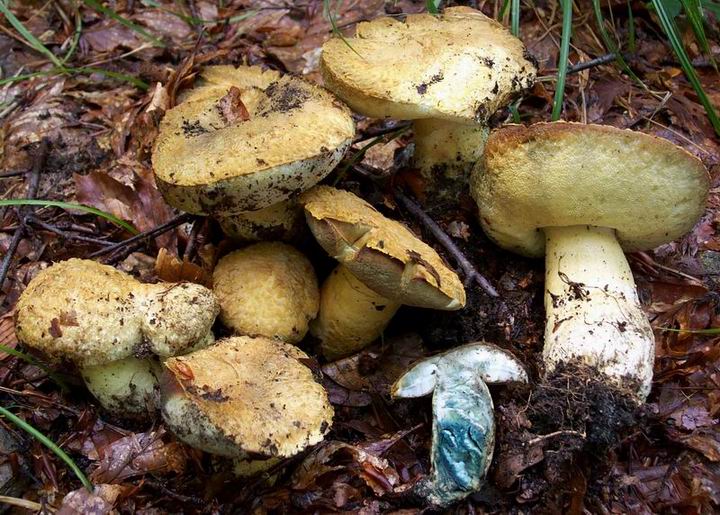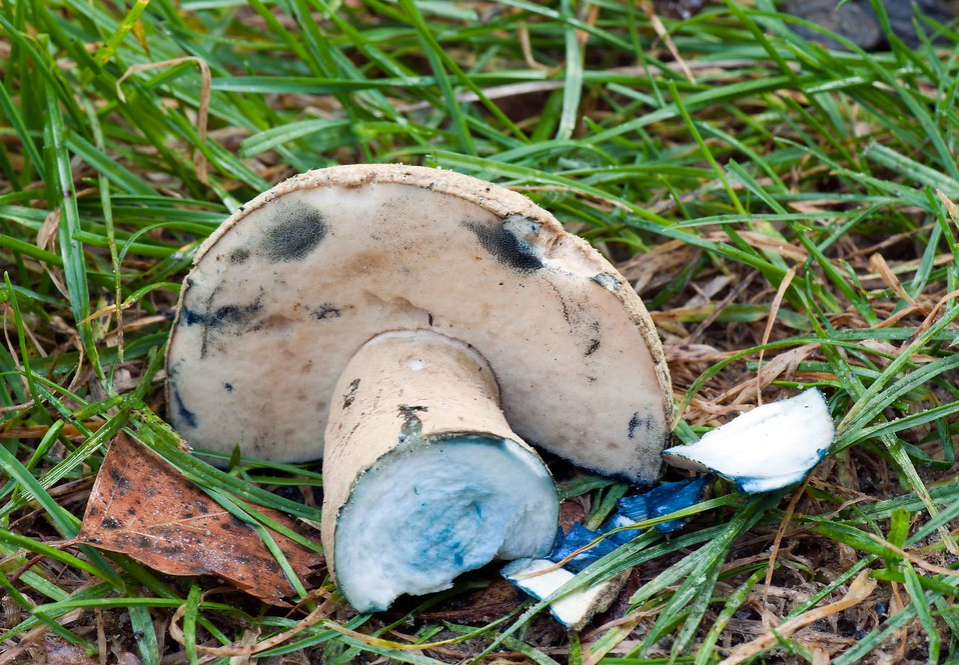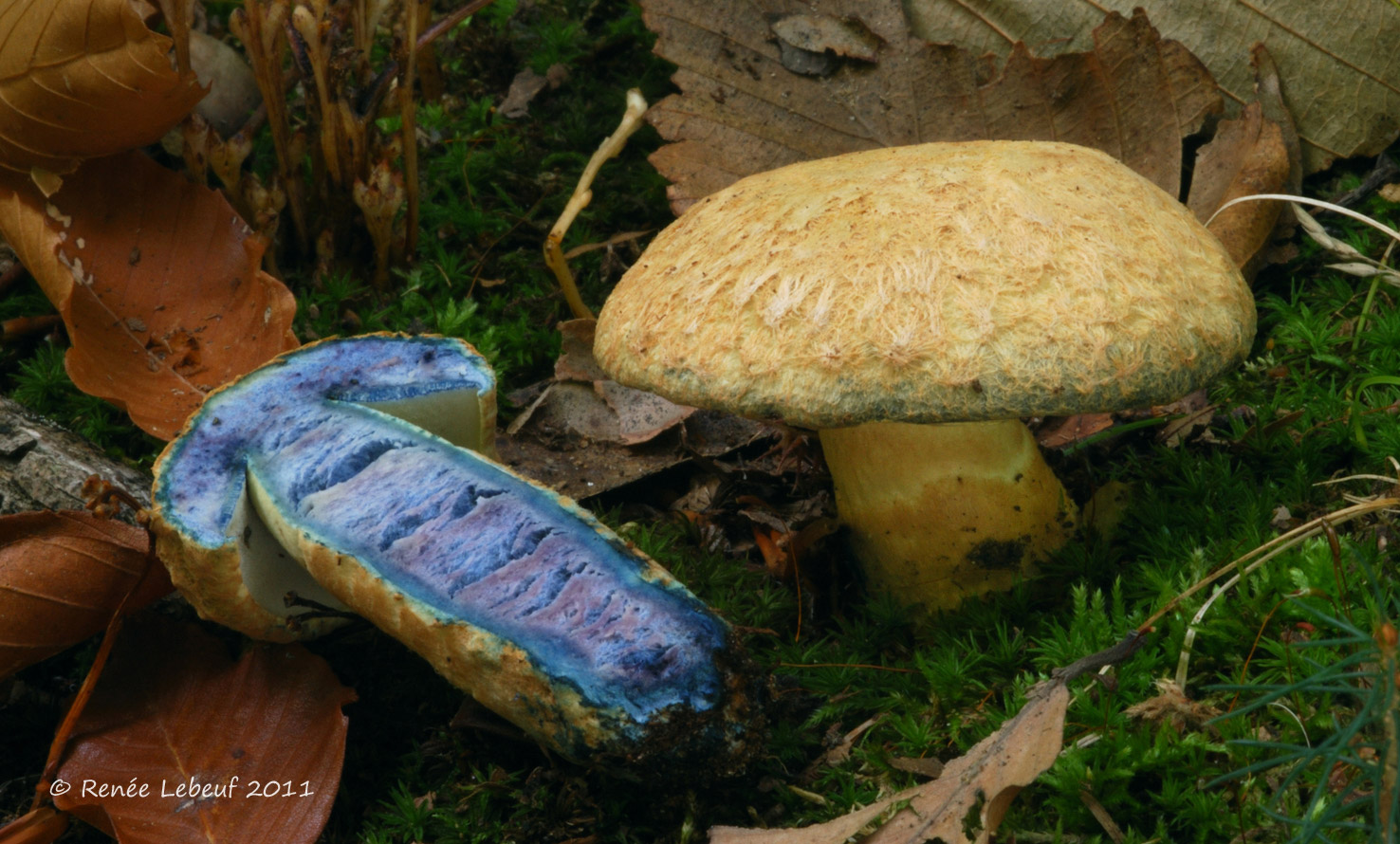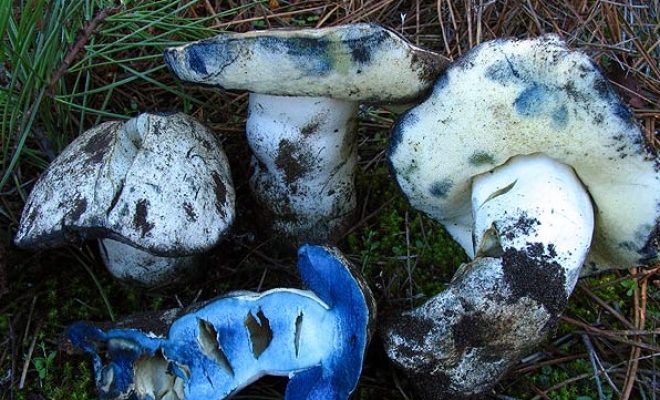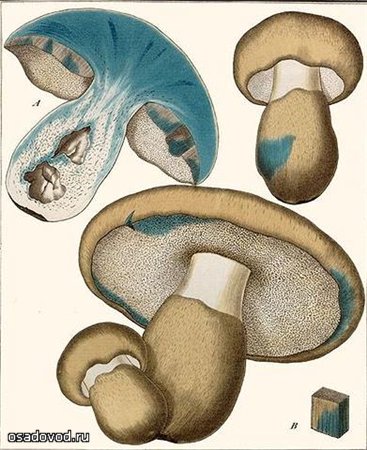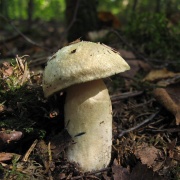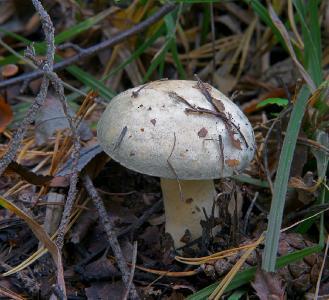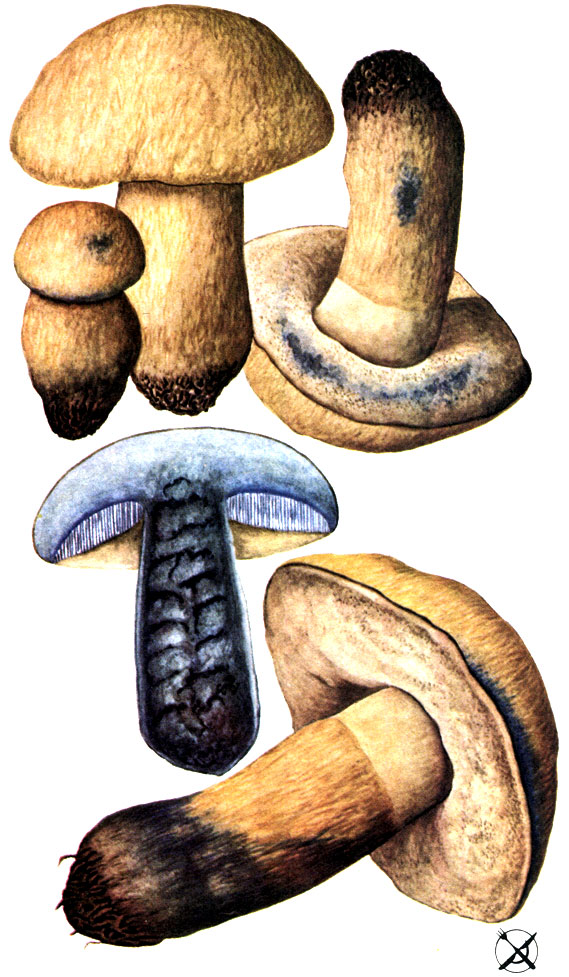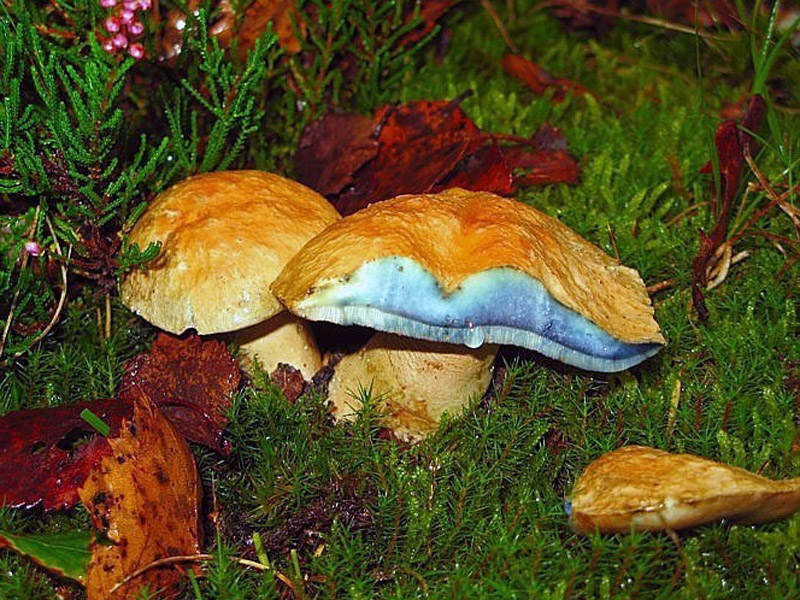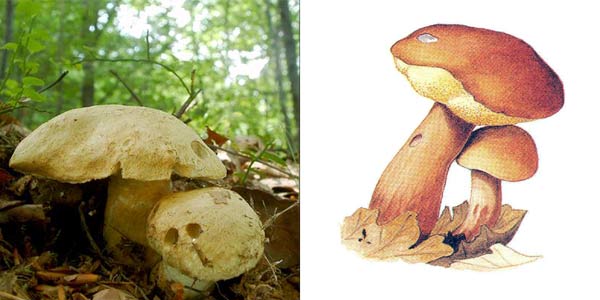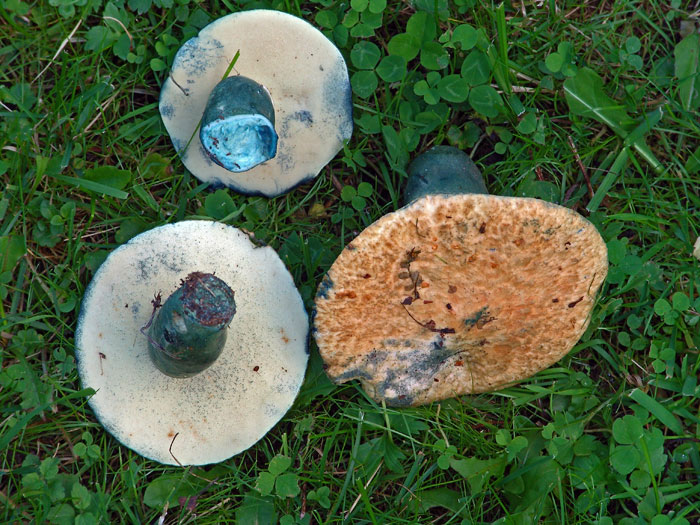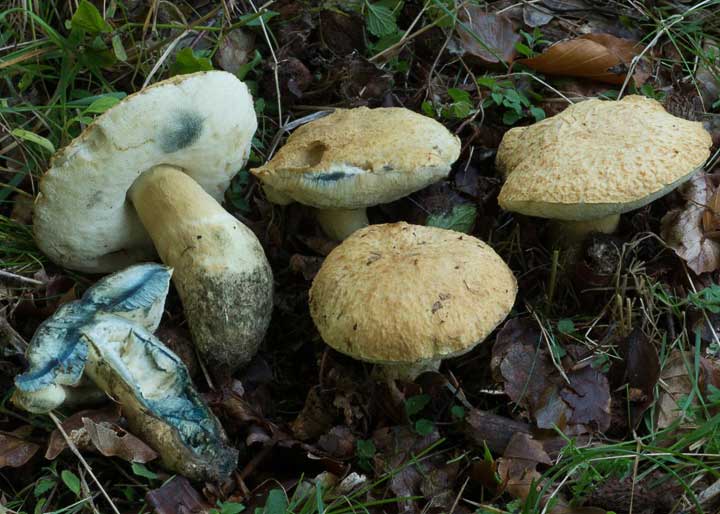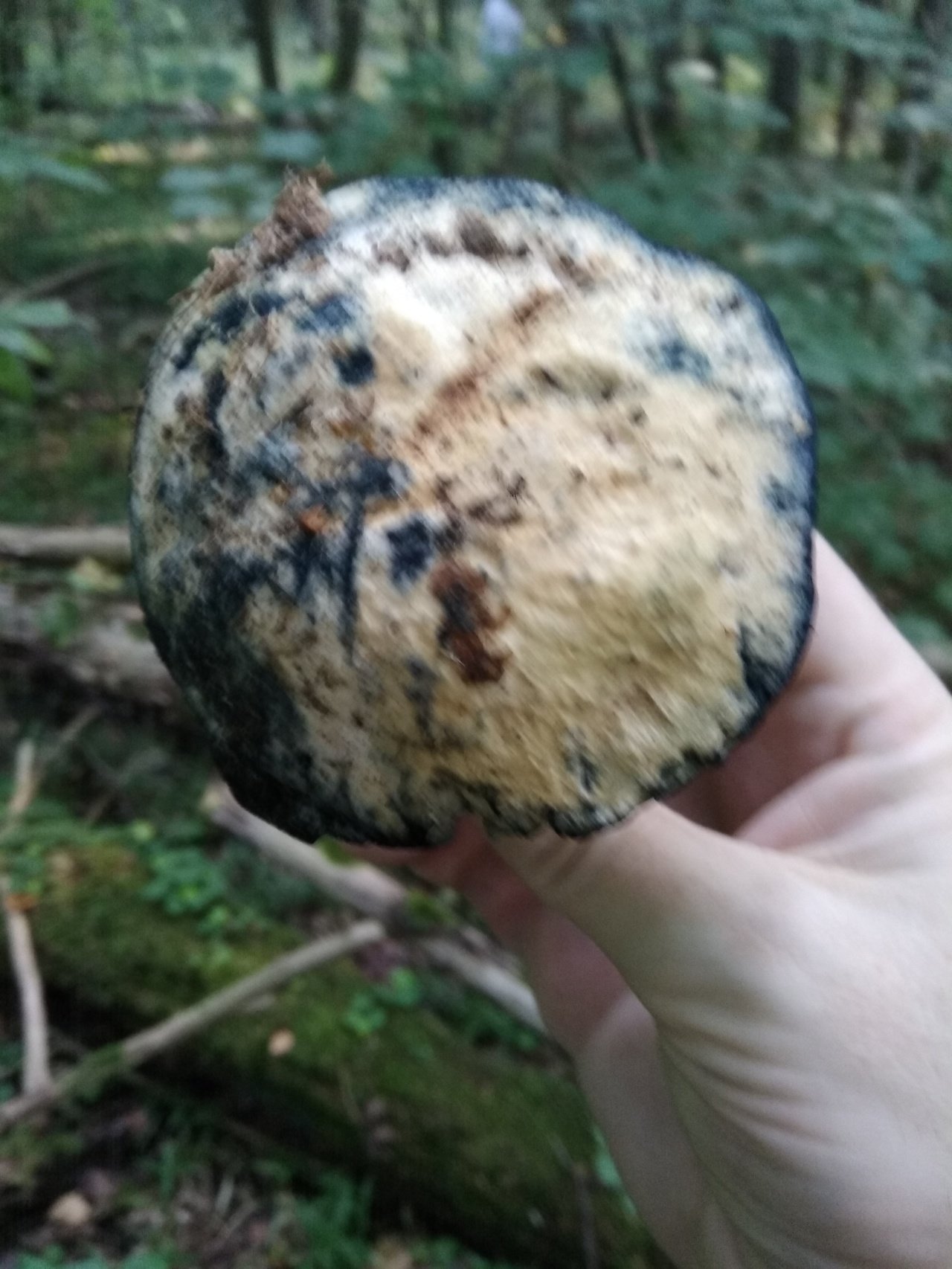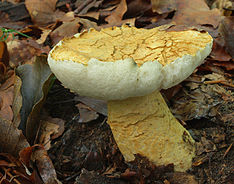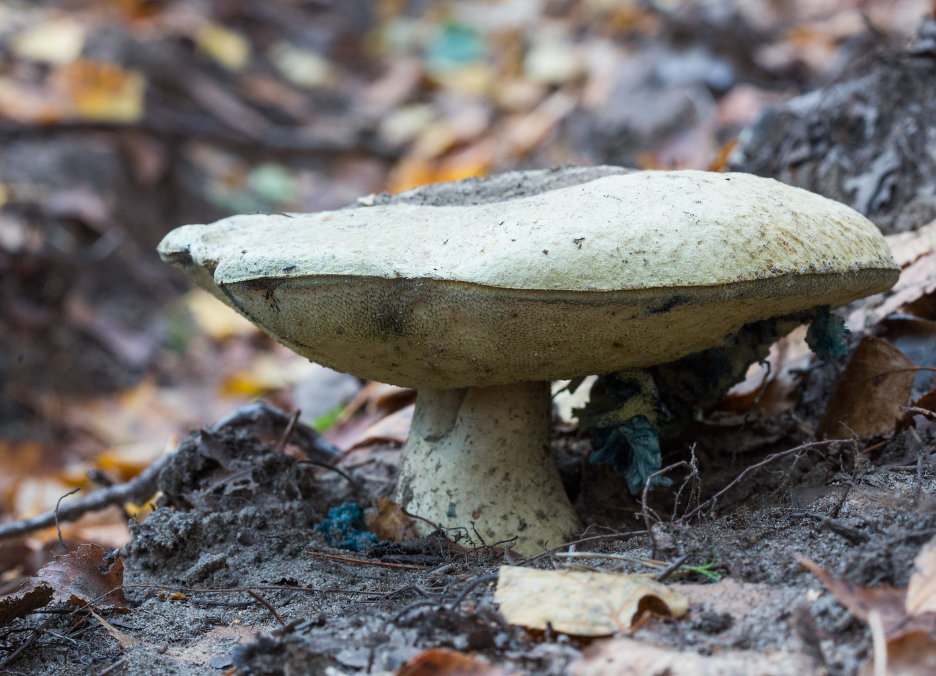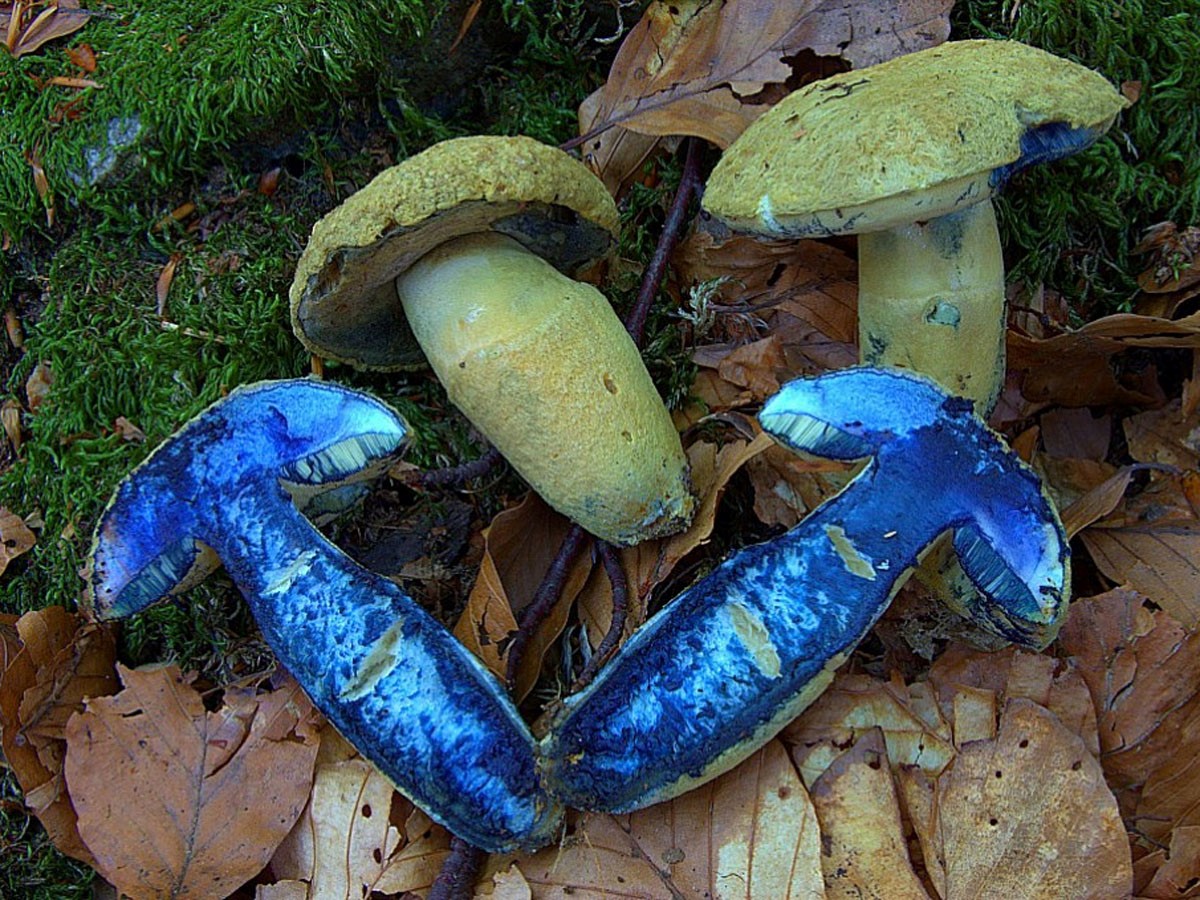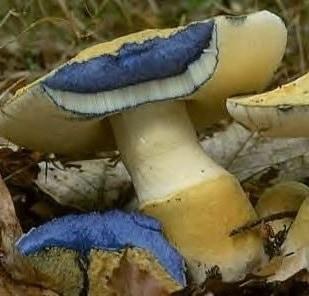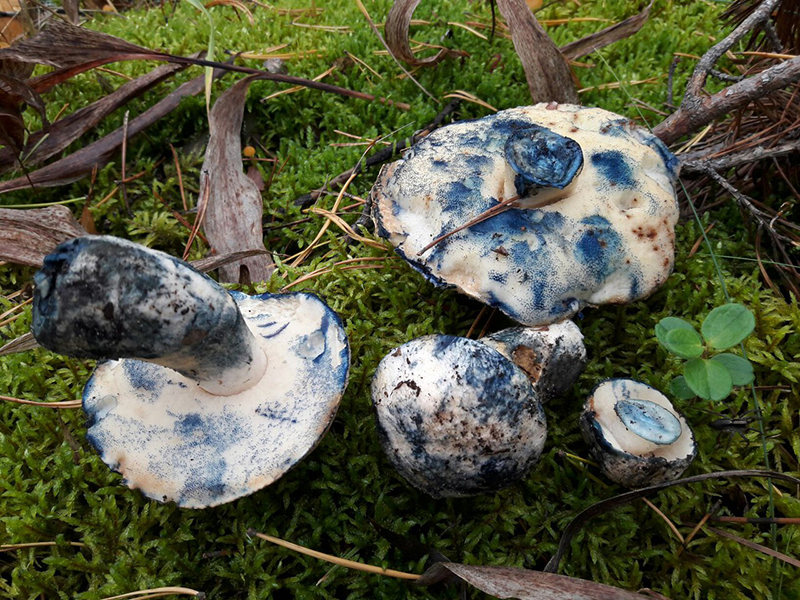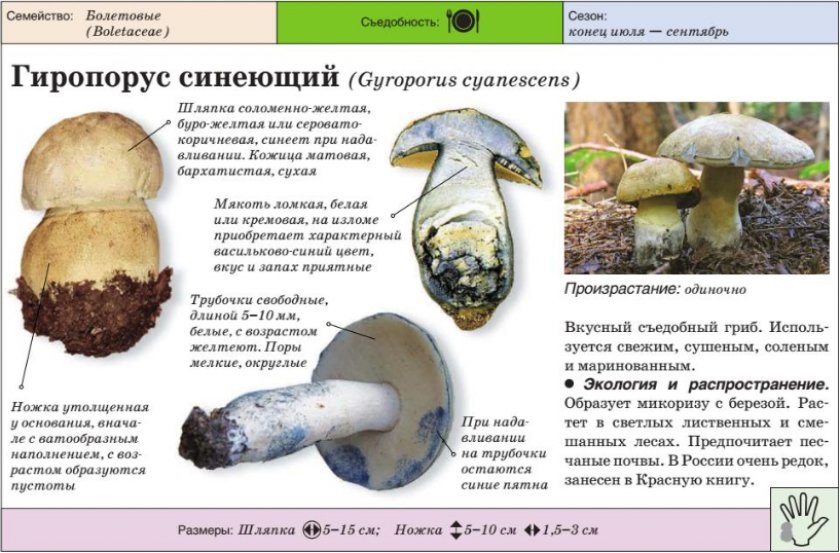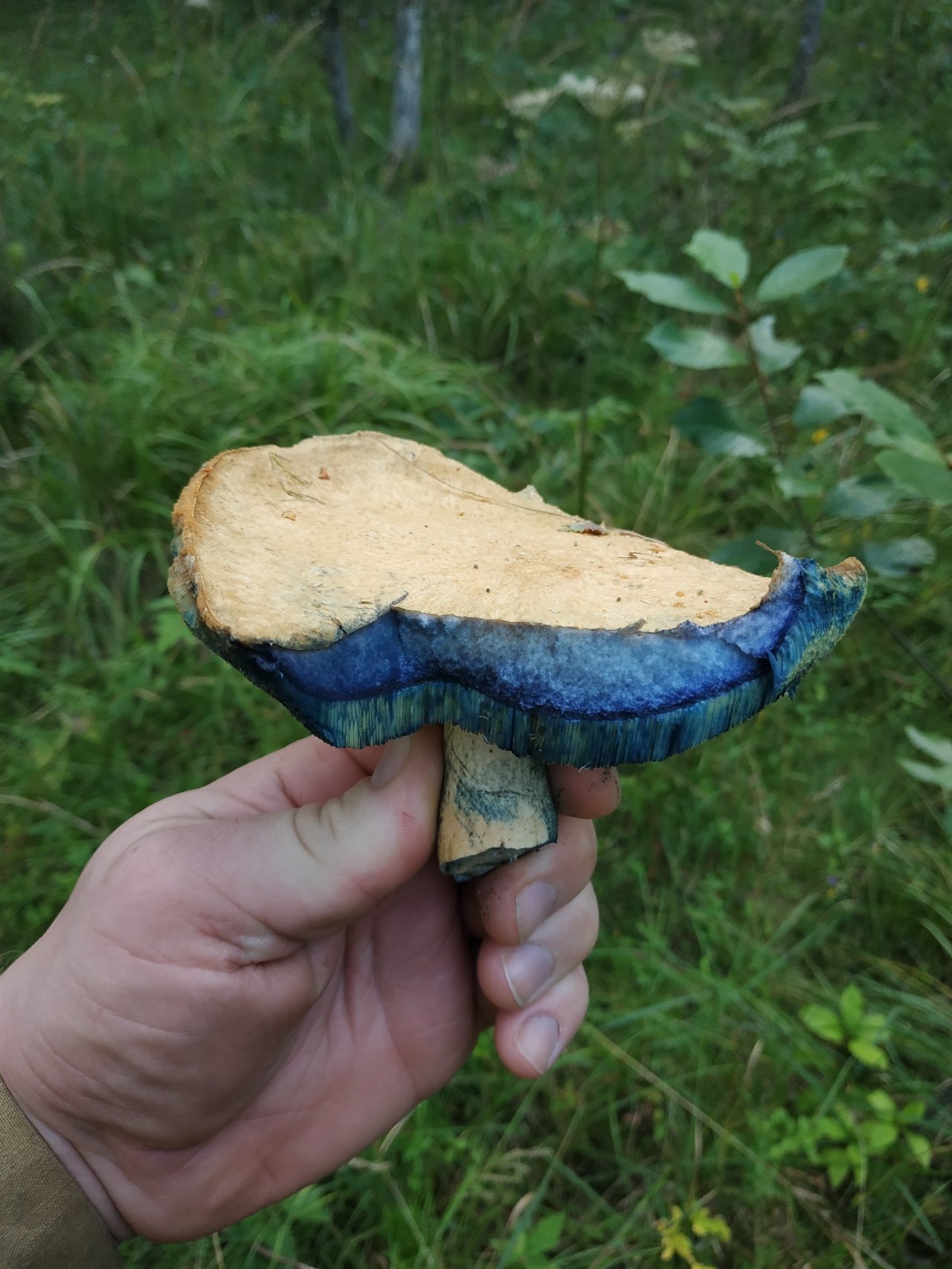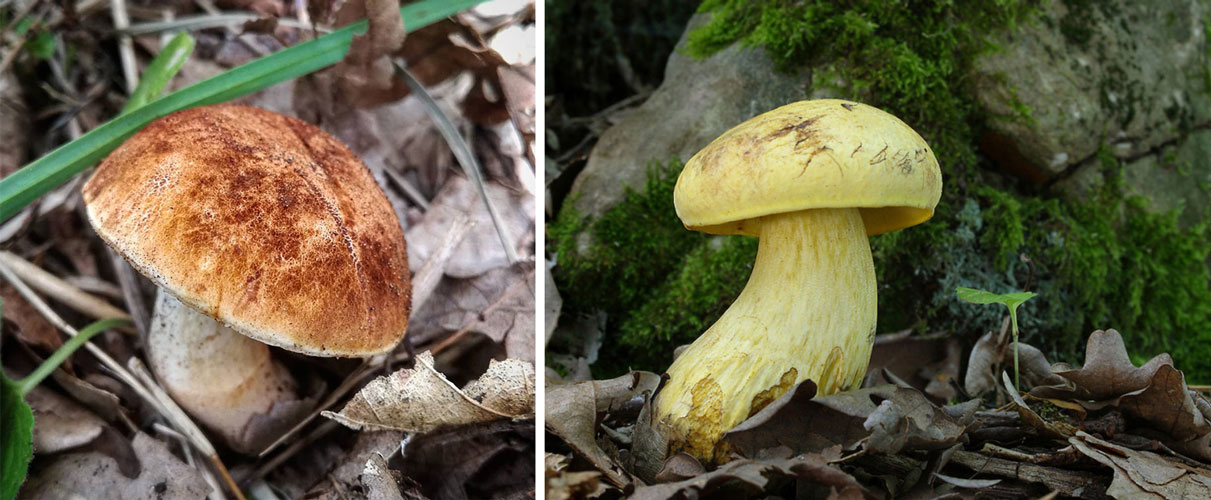Gyroporus blue (Gyroporus cyanescens)
- Other names for the mushroom:
- Blue boletus
- Bruise
Synonyms:
- Boletus cyanescens
- Boletus constrictus
- Leccinum constrictum
- Suillus cyanescens
- Suillus cyanescens
- Leucoconius cyanescens
The popular name "Bruise" accurately conveys the behavior of the fungus at the slightest damage to tissues, whether it be a cut, break or just a touch: it turns blue. The color change occurs quickly and very clearly, which makes it possible to almost unmistakably distinguish Blue Gyroporus from other boletus.
Description
Hat: 4-12 cm, sometimes up to 15 cm in diameter. Convex at first, then widely convex or sometimes almost flat in age. Dry, roughly rough or sometimes dull-scaly, covered with fine hairs. Straw or pale brownish, brownish yellow. It turns blue when touched.
Hymenophore: tubular. The surface of the pores (tubes): from white to yellowish, straw color, instantly turns blue when pressed. Contains 1-3 round pores per mm. Tubes up to 18 mm deep.
Leg: 4-12 cm long, 1-3 cm thick. More or less flat or with a slight thickening in the middle part, it can taper towards the very bottom. In young specimens, it is completed, with age cavities form in the leg, in adults it is practically hollow. The leg is visually divided into two parts: at the top, directly under the cap, it is light and smooth. Below - in the color of the cap, matte, slightly pubescent. There is no ring, but the upper and lower parts of the cap are separated so sharply that you involuntarily look for where the ring is.
Flesh: white to pale yellow, brittle, brittle. It turns blue very quickly on the cut.
Smell and taste: weak mushroom, sometimes there is a pleasant, nutty taste.
Chemical reactions: ammonia negative or pale orange on the surface of the cap, negative to brownish on the flesh. KOH negative to orange on the surface of the cap, negative to brownish on the flesh. Iron salts from olive to almost black on the pulp.
Spore powder print: pale yellow.
Microscopic features: Spores of variable size, but mostly 8-11 x 4-5 µm (however, often as small as 6 x 3 µm and as large as 14 x 6.5 µm). Smooth, flowing, ellipsoidal. Yellowish in KOH.
Edibility
Blue gyroporus is suitable for human consumption. It is used dried, pickled and boiled. The data on taste are contradictory: someone thinks that it is not inferior to porcini mushroom, someone notes "very mediocre" taste.
Ecology
Various sources mention mycorrhiza with deciduous species, and different ones, such as birch, chestnut, oak. There is even an assumption about mycorrhiza with conifers, with pine. But, as noted by Singer (1945), Blue Gyroporus grows "in forests and even in meadows" and "apparently does not regularly form mycorrhiza, at least no preference for any forest tree has been proven, since sometimes fruiting bodies are formed far enough from any tree. "
Grows alone, scattered or in small groups, usually in sandy soil, especially in soil with destroyed structure (roadways, shoulders, parks, etc.)
Season and distribution
Summer and autumn. The mushroom is quite widespread in America, Europe, Russia.
Notes Considered a rare species. Blue gyroporus is listed in the Red Book of Russia.
According to some authors, Gyroporus cyanescens var. violaceotinctus differs from var. cyanescens: The flesh turns blue instantly to a rich violet-blue without going through the greenish-yellow stage. According to Bessette, Roody & Bessette (2000), a variety harvested in North Carolina does not bruise at all.
Gyroporus blue contains the pigment boletol, it is an antibiotic. It was isolated not only from the bruise, but also from some species of oak trees.
In the article and in the gallery, photos were used from the questions in recognition: Gumenyuk Vitaly and others.
Gyroporus chestnut
Another representative of the gyroporus family. Belongs to the department of basidiomycetes, forged agaricomycetes. Genus: gyroporus.
Hat
The cap of this mushroom has a characteristic rusty hue with brown spots.Less often it is red-brown. Even less often chestnut shade. The younger the mushroom, the lighter its cap, but with age it becomes darker. The diameter of the mushroom reaches 11 cm. The surface of this mushroom, if you run your hand over it, is quite velvety. Also a little fluffy. Less often, it is naked and without a single villi. If the sun's rays hit directly on the cap of the mushroom, it begins to crack. If you look under the cap, then the tubes inside are first white, then they acquire a yellow tint. As for the older age, the cap becomes less elastic and drier.
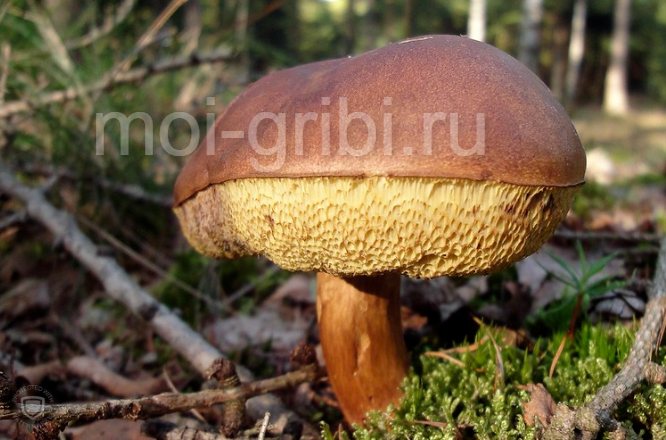
Pulp
Special attention is paid to the pulp. It is quite white, and at the same time tries not to change its color at the cut
At first, it is quite hard, while fleshy. However, it becomes more fragile with age. At the same time, her smell and taste is quite unpleasant, so many people prefer to bypass the chestnut side of gyroporus.
Leg
The leg is quite stable. It is unevenly cylindrical, but at the same time, it can bend at any angle. Clavate and fairly flattened. Dry, up to 30 mm in height. The thickness is the same. Inside, the leg is quite elastic, but with age, this elasticity is commensurately lost. Often, the cap outweighs the leg and breaks it off.
Where to grow and when to go
If you are looking to find Chestnut Gyroporus, you are very lucky. This mushroom is especially widespread in the central territory of Russia. It grows immediately as a large brood, therefore, having spotted it in a clearing, know that there are probably many of its fellows around.
This mushroom grows from July to right until November, but on condition that the autumn is warm. If it is cold, then you need to go for the mushroom at the end of September and beginning of October.
Prefers coniferous and deciduous forests for growth. Also, predominantly prefers sandy soils, cut wet. Loves dry soils, settles away from swamps.
Fruiting bodies are somewhat widespread from each other, however, they are nevertheless grouped well. In one glade, you can find up to thirty mushrooms at a time.
Edible Gyroporus chestnut
Many people say that chestnut gyroporus is much worse in its taste characteristics, in contrast to blue gyroporus. This is indeed the case. Despite the fact that this mushroom is edible, it still has a very specific taste.

First, you smell the champignons, and then it takes on a bitter tint. Even after heat treatment, this mushroom cannot be eaten. At some point, it becomes so bitter that there is nothing to do but throw it away. Also, he can impregnate absolutely all the ingredients that were prepared with him with bitterness. For example, if gyroporus is mistakenly baked with potatoes, the potatoes will also become very bitter.
Therefore, it is predominantly better to use such a mushroom as a seasoning. Indeed, a slight bitterness will not hurt some people, and in general, this mushroom perfectly replaces pepper, it becomes more aromatic.
To prepare the seasoning, you must perform a number of the following actions.
To begin with, the mushroom is washed well under running water.
All rubbish is removed. The mushroom is dried well and cut into several pieces. Then boil in boiling water for about 10 minutes. The mushroom is salted again and then carefully placed on baking paper on a baking sheet. The temperature in the oven is set at 60 to 70 degrees. Mushrooms go there for one and a half to two hours.
However, check readiness periodically. To do this, you need to take a piece of the mushroom in your hands and try to break it. As soon as this happens with a crunch, it means that the drying cycle is over. Now you need to let the mushrooms cool down at room temperature. However, try not to get wet around. Once the mushroom has cooled down, we suggest grinding it in a coffee grinder. Done, tasty and bitter seasoning will decorate any of your dishes.
Description
In Latin, the chestnut mushroom is called Gyroporus castaneus (chestnut gyroporus), and in the common people - Chestnut, hare or sand. It belongs to the Boletov family, a genus of tubular Gyroporus.
Hat
The color of the cap of a chestnut mushroom is rusty-brown, red-brown or chestnut-brown; in a young mushroom, its shape is convex; as it grows, the cap becomes flat or cushion-shaped, with a diameter of 4 to 11 cm.The surface of the cap in young chestnut mushrooms is velvety or slightly fluffy, often becomes naked with age. During dry weather, the cap of the mushroom often cracks. The tubules are white, yellow in the old mushroom, do not change color on the cut, adherent at the stem, gradually become free, their length is up to 8 mm. The pores are small, rounded, at first white, then yellow; when pressed, brown spots remain.
The pulp is white, the color does not change at the break, the aroma is weak, mushroom, the taste resembles a hazelnut.
Leg
The leg is cylindrical, slightly thickened at the base, solid in a young mushroom, cavities appear in it with age. The color usually approaches the color of the cap, or lighter. Leg length 3.5-8 cm, diameter 0.8-3 cm.
The older the body, the fewer villi on its cap. It may crack at the edges if the summer is dry. The cut of the leg does not darken. The old chestnut mushroom has a hollow tubular stalk that is thickened towards the ground. Height depends on weather conditions, height is from 3 cm to 8 cm.
The pulp of the chestnut mushroom is characterized by fleshiness and white color. It is fragile in a young organism, and the old hare mushroom has a hard and dry flesh.
This rare forest organism, chestnut mushroom, is listed in the Red Book of Russia. It grows under broadleaf trees. Forms mycosis with beeches, oaks and conifers.
Harmful properties
Mushrooms contain a lot of plant fibers and chitin, which are difficult to digest, which is why nutrients are poorly absorbed. To eliminate this, the mushrooms are dried, thoroughly ground and sent for storage in hermetically sealed jars in a dark place.
Important: edible salt is added to the mushroom powder. This drug is used as a seasoning.
There are many toxic and radioactive substances in the atmosphere that are absorbed by edible mushrooms
Therefore, collecting them along roads and in areas with industrial enterprises is associated with a danger to life. You should not buy mushrooms from the market, as it is not known where they were collected. Perhaps in an ecologically polluted area.
Don't go mushrooming alone. Remember, if a poisonous mushroom gets into the basket, it can lead to the poisoning of all its relatives. Better get rid of the contents of the basket.
Mushrooms are considered a heavy food, so they should not be consumed by babies, nursing and pregnant women and people with various diseases of the digestive tract.
Mushroom time is called a quiet hunt. Be careful that this silence does not make you worry. Collect only edible mushrooms!
Poisonous and inedible mushrooms
Kele's Dubovik (Boletus queletii)

The hat is up to 15 cm in diameter, round or convex. The surface is chestnut brown, velvety in young mushrooms, in mature mushrooms it becomes smooth, dry, the skin does not peel off. The pulp is fleshy, dense, yellowish, brown in the stem, turns blue on the cut. The leg is 4-15 cm high, 1-3.5 cm thick, cylindrical, thickened towards the base, solid. There are no patterns and scales on the surface, the color is yellow-brown.
A rare species that grows in deciduous forests of Russia, the Caucasus, the Far East. Fruiting season May-October
Satanic mushroom (Boletus satanas)
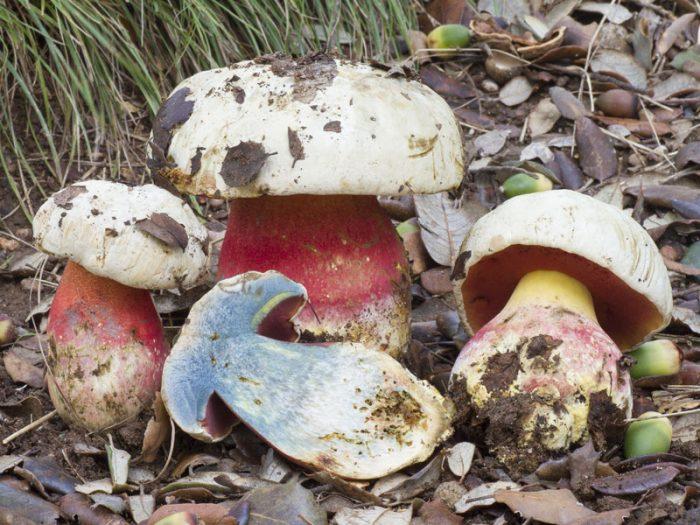
The diameter of the cap is 8-25 cm, the shape is hemispherical, rounded-cushion-shaped, in mature mushrooms it becomes widespread, the surface is smooth or velvety, dry, painted in white, grayish, green-gray, rarely with a yellow tint.The flesh is white or yellowish, red in the stem, slightly blue or reddish in the cut, reddish in the stem. Mature mushrooms have an unpleasant odor. The leg is 5-15 cm in height and 3-10 cm in thickness, in young mushrooms, ovoid or spherical, later becomes tuberous, barrel-shaped or turnip, tapers upwards, dense, painted yellowish-red on top, bright red in the middle, brownish yellow at the base. Covered with a mesh pattern.
It grows in deciduous forests, under oaks, beeches, hornbeams, hazel, chestnuts, lindens, on calcareous soils. Found in southern Europe, Russia, the Caucasus, the Middle East, Primorsky Territory. The growing season lasts from June to September.
Types and their description with photo
Several types of mushrooms are classified as bruises. These are gyroporus, tubular-cap, heading the genus Gyroporus, and the Giroporov family and Duboviks from the Borovik family of the Boletov family.
These are edible mushrooms, their pulp has the characteristic property of being colored blue or its shades. They have a spongy stem, central, without a mesh pattern. The pulp is light, the hymenophore folds loose tubules and regular rounded pores. Their individual characteristics are as follows:
-
Gyroporus blue - an edible mushroom, has a velvety cap, reaching 15 cm, which can be convex or flat, light yellow or darker, up to brown. At the same time, the pulp is white-cream, after breaking it acquires a bright cornflower blue hue. The leg is up to 10 cm, conical with a thickening at the bottom, in young mushrooms it is filled with cotton-like tissues, and in mature specimens it is hollow.
It grows more often near birches, oaks and chestnuts, prefers sandy soil in mixed and deciduous forests. Fruiting from July to late September. It has a strong pleasant aroma and taste without bitterness; it is used dried for further preparation of soups and sauces.
-
Oak olive-brown - refers to conditionally edible, requires compulsory boiling with subsequent replacement of water, otherwise it can cause stomach and intestinal disorders, especially with the simultaneous intake of alcohol. It is easy to distinguish from edible species, it has a very large cap (up to 20 cm), brown with an olive tint.
The pulp is yellow, the base of the leg is reddish. With any pressure, the entire mushroom becomes covered with spots, on the breaks the fruit body turns blue, but soon becomes brown. It settles on calcareous soils of mixed forests. It is thermophilic, the harvesting season is August. More often they are harvested in pickled form.
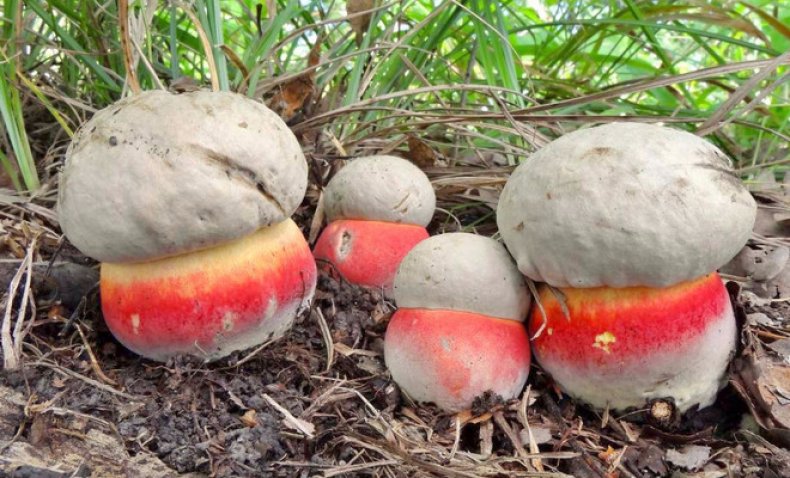 You may be interested in:
You may be interested in:
What does a satanic mushroom look like and is it edible or not (21 photos)?
The Satanic mushroom, or Satan, is a rare species that mycologists classify as poisonous. The mushroom is considered ... Read more ...
-
Speckled oak - at a young age, it stands out with a convex matte cap of different brown shades. The stem is red-yellow, tuberous or barrel-shaped with red scales. When cut, it acquires a blue-greenish color in the cap and reddish in the stem.
Loves acidic soil, swampy areas and mosses, more often found in coniferous parts of the forest. Begins to bear fruit in May, can be found until the end of October. Since the mushroom is conditionally edible, it cannot be consumed without preliminary 15-minute boiling. It is used more in dried form.
Caviar
How else can you use bruise mushroom? Cooking caviar from it will not take the slightest amount of time, but the delicious food turns out to be notable! And you just need something: a kilogram of bruises, three hundred grams of onions, vegetable oil for frying, a head of garlic, spices to taste and salt.
- We use all the same semi-finished product, boiled in advance. Chop the mushrooms finely.
- Chop the onion and fry until golden brown.
- Add mushrooms and fry for 10 minutes over low heat. If too much juice is released, drain it.
- We remove from heat and let cool to room temperature.
- Pour the mixture into a blender (you can in parts, since everything may not fit at once) and grind. Then put the resulting mass in a pan and simmer over low heat for another 15 minutes, adding mushroom juice. At the very end of cooking, add crushed garlic and spices with salt. Caviar is very good both cold and hot. You can also spread it on bread as a sandwich.
Blue lump
This mushroom is widespread throughout our country, but prefers to grow in the forests of Siberia and the Urals. Many residents of foreign countries consider it inedible, but this is not the case. It's just that the cooking technology is a lot of trouble. This mushroom has many names: purple, blue, lilac, canine.

Many edible mushrooms turn blue when cut. A typical representative is a blue lump. Its cap reaches fifteen centimeters in diameter and is yellow. If the mushroom is cut or pressed, it turns blue. Hence the name. The cap of young milk mushrooms is slightly convex, but in the process of their growth and aging, it becomes prostrate or depressed. Blue mushrooms are mushrooms that turn blue when cut. The photo clearly demonstrates this. The mushroom is distinguished by dense and thick pulp, which is yellow, light brown or cream in color. Interacting with air, the white juice acquires a lilac color.
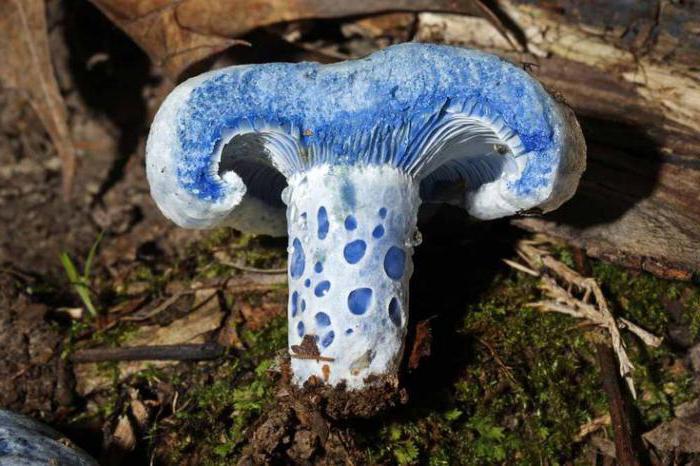
This mushroom has no counterparts. Mid August - early September is the best time to collect blue mushrooms, which are rich in mixed and coniferous forests. They hide under birches and spruces. These mushrooms are fried or boiled. They are not pickled, as both the mushrooms and the liquid turn blue.
(gyroporus)
✎ Affiliation and generic features
Gyropor or gyroporus (lat.Gyroporus) is a genus of mushrooms of the gyroporic family (lat.Gyroporaceae) and a large order of boletus (lat. Boletales).
The family of gyropores (lat.Gyroporaceae) is monotypic (a group containing one directly subordinate taxon) and contains a single genus Gyroporus, which, according to recent studies (from 2008), collects only a dozen species in all.
The genus of gyropores is a very narrow genus of fungi and unites no more than 10 species that live in the temperate zone of the Northern Hemisphere, sometimes in the tropics.
On the territory of Russia, only 3 of them are considered the most famous, and these are:
- chestnut gyropore (chestnut, chestnut mushroom);
- birch gyropore (subdubovik, ink mushroom);
-
sandy gyropore (sandstone, sand mushroom)
,
and only the first 2 are significant for mushroom pickers, since the third species is toxic, weakly poisonous, although until recently it was a common variety of edible chestnut gyropore (lat.Gyroporus castaneus).
Gyropores are extremely rare edible (like chestnut gyropore) and conditionally edible (like birch gyropore) species included in the Red Book of Russia, forming mycorrhiza with very many broad-leaved species (oaks, beech trees, ash trees, elms, maples, linden trees, chestnuts), and sometimes with conifers (pines).
✎ Similar appearance and nutritional value
Gyropores, in addition to being similar to some edible mushrooms, can also resemble inedible ones.
Gyropors have such a double, and this is a gall mushroom from the genus Tolopil (tolopilus), with which they are united by the bitter taste of pulp, but distinguishes between a hollow, or with voids inside, a leg, as well as a blue pulp at a break.
At the same time, it should be noted that gyropores have no similarities with poisonous species.
In terms of nutritional quality and nutritional value, gyropore mushrooms are edible, or conditionally edible, mushrooms of the second category.
Gyropores, due to their rare prevalence, are recognized as very desirable, and in the gastronomic plan - delicious mushrooms.
So, any mushroom picker will be glad to find them, and any culinary specialist (with caution, but pleasure) will prepare an obvious masterpiece from them. But it is worth considering that gyropores are listed in the Red Book of Russia and their collection is pure poaching.
✎ Distribution in nature and seasonality
Gyropores usually prefer mixed broad-leaved or pine-oak forests, and they always choose not dense, lighted and dry areas. At the same time, they do not like to climb deep into the forest, but settle along the forest edges.
Most likely, gyropores are widespread in Western and Eastern Europe, very rich in broad-leaved trees and are found mainly in the southern regions from France to the Far East, but everywhere they are extremely rare.
On the territory of Russia, gyropore fungi are found even less often (in the temperate zone), where there are broad-leaved forests. And these are the western, southwestern outskirts of the country, the south of the European part, the Caucasus, partly Western Siberia and the Far East.
Gyropores do not bear fruit for a long time, usually from late July - early August to mid or late September.
✎ Brief description and application
Gyropores are common representatives of the section of tubular fungi and the inner zone of their cap has a porous structure. The tubules of the hymenophore (spore-bearing layer) of the gyropores are pale yellowish or coral-chalk in color. The caps of young fruits are very dense and fleshy, colored from light chestnut and orange-brown to reddish-brown, noticeably dry and velvety, or smooth to the touch. Legs without a mesh pattern, loose, in ripe fruits with voids inside or hollow. The flesh in the cap is dense, elastic, loose in the stem, white in color, and on the cut at the birch (blue) gyropore it sharply changes color, and does not change the chestnut color in the chestnut gyropore.
Different gyropore mushrooms are also cooked in different ways. Some of them (chestnut mushrooms), when boiled, are slightly bitter and therefore they are usually dried or fried raw, but not salted or pickled, because their brine tastes bitter and spoils the dish.
Others (podduboviki) can be used "raw", without prior boiling, in frying, salting, pickling, drying or in the preparation of mushroom sauces.
Description
The bruise mushroom (in scientific Latin called Gyroporus cyanescens), also known as the blue gyroporus or birch gyroporus, belongs to the tubular mushrooms of the genus Gyroporus (gyroporic) of the Boletov family of the Agaricomycetes class. It received its names, both popular and official, for the rare property of its pulp. For example, in a leg or a hat, it is quickly able to change its original white color to a bright and saturated blue. Moreover, in any place of damage, whether it be a cut of a mushroom picker knife, pressed fingerprints or, for example, an animal bite.
The shape of the bruise's cap changes depending on its age - in young mushrooms it has a convex shape, but as it grows, it gradually becomes flattened. The skin of the mushroom has a pleasant matte appearance with a yellowish-brown or whitish-cream color; at the slightest damage it becomes covered with bright blue spots. To the touch, the surface of the blue gyroporus cap is dry and has a velvety felt texture. Its average diameter is 5-8 centimeters, although specimens with a cap width of 15 centimeters are often found.
The flesh of the bruise mushroom has a white or delicate creamy color, easily breaks, acquiring a cornflower blue hue at the place of the break or cut. The taste is nutty, there is practically no characteristic smell. The tubular layer of the fungus, up to 10 millimeters thick, with small pores, also has a white or cream shade, which immediately turns blue when damaged. The spore powder has a pale yellowish color.
The smooth leg of the blue gyroporus, devoid of a ring, reaches a thickness of up to 3 centimeters, and a height of 5 to 10 centimeters. At the base, it is thickened, and under the cap it has a pointed shape. The color, as a rule, is either white, or copies the color of the cap, sharply giving back to the blue after touching. The structure of the stem of a young mushroom is dense, and in an adult it is hollow.Bruise is considered an edible mushroom belonging to the second food category, with a not bitter taste in food, which has a fairly good nutritional value, for example, compared to other members of its family, such as chestnut gyroporus.


